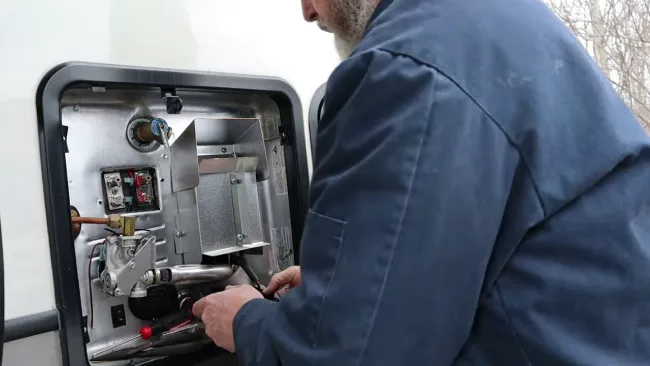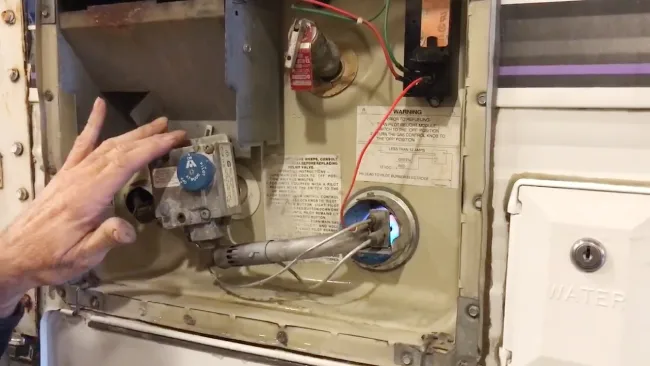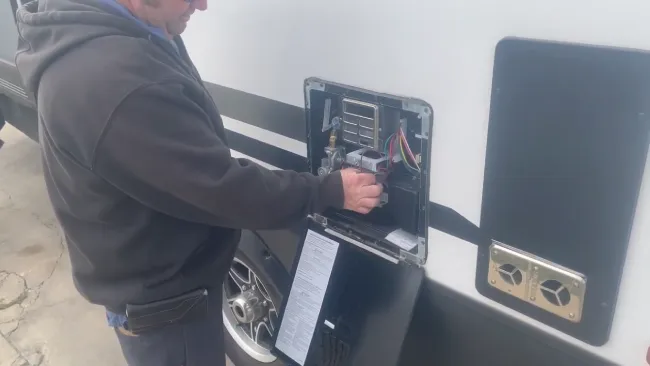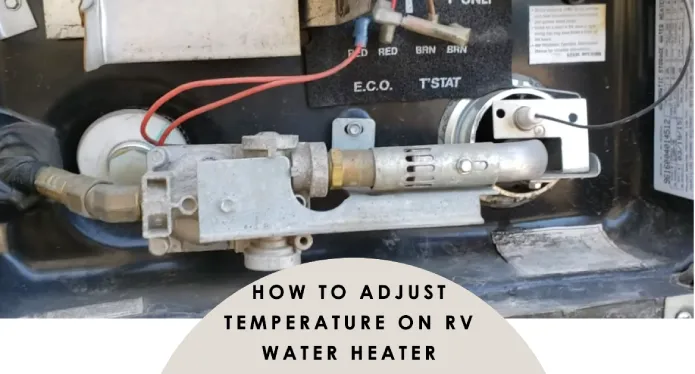Last Updated on June 11, 2023
Achieving the perfect hot water temperature on your RV adventure is as simple as adjusting your water heater. With easy-to-follow steps, you can enjoy warm and inviting showers without any discomfort or fear of scalding.
To adjust the temperature of your RV water heater, you need to locate the water heater. Once you know where the temperature control is, turn the knob carefully to adjust it. After that, you’ll be able to enjoy the ideal water temperature during your travels.
Alright, let’s look at these steps and find out how to tweak your RV water heater’s temperature easily. Grab your water heater & gear, and let’s do this thing.
How to Adjust Temperature on RV Water Heater: Step-By-Step Guide

If you’re looking to change your RV’s water heater temperature, here are the steps you need to follow:
Step #1: Locate the Water Heater
Step #2: Access the Water Heater Controls
Step #3: Adjust the Temperature
Step #4: Check the Temperature
Now let’s get into the details.
Step #1: Locate the Water Heater
Before doing anything else, make sure you know where your RV’s heating system is located. The water heater may be on the RV’s exterior or inside a dedicated utility compartment.
Step #2: Access the Water Heater Controls
Now that you’ve found the spot where the magic happens, it’s time to take a peek behind the curtain and uncover the controls that make your hot showers possible.
Depending on the type of water heater, you may need to open a small door or remove a panel to access the controls.
Look for a cover that can be removed, exposing the controls and components. Once you’ve located the access point, use a screwdriver or other tool to remove the cover and reveal the inner workings of your water heater.
Inside, you’ll see a variety of knobs and switches that control the temperature and other settings.
Take a moment to familiarize yourself with the layout and functions of the controls. Some models may have a digital display, while others have analog knobs.
Regardless of the type, the temperature control should be easy to identify. It’s typically labeled with a simple temperature gauge and can be adjusted with a simple turn of the knob.
Step #3: Adjust the Temperature
It’s time to turn up the heat and make your showers more comfortable by tweaking the thermostat on your RV’s hot water system.
Whether it’s a knob or dial, you can use your bare hands or a handy tool like a screwdriver to adjust. Just remember to take baby steps and avoid sudden or drastic changes to the temperature, as this can cause scalding or discomfort when using hot water.
Start with small adjustments, turning the knob or dial clockwise to increase the temperature and counterclockwise to decrease it.
Even slight rotations can noticeably impact the water temperature, so be cautious about following the control’s temperature indicators.
Step #4: Check the Temperature
You’ll want to ensure the hot water from your faucets and shower is safe and comfortable before hopping in for a relaxing shower.
After adjusting the temperature on your RV water heater, remember to check the temperature to ensure it’s set to your desired level. Be cautious when testing the hot water to avoid burns.
Run hot water through the faucets or shower to confirm the new temperature. If the initial adjustment isn’t satisfactory, you can repeat the process, making small incremental changes until you achieve the desired temperature.
When Should You Adjust the RV Water Heater’s Temperature?

There are a few situations where you’ll need to adjust the temperature on an RV water heater:
1. Initial Setup
When acquiring your RV or installing a new water heater, adjusting the temperature to your desired setting may be necessary. Finding a comfortable level for you and your fellow travelers is essential.
The default temperature may not be suitable for your preferences or needs. It would help if you adjusted the temperature to your liking, which can be easily done with the RV water heater’s settings.
2. Seasonal Changes
Adjusting the water heater temperature throughout the year to suit the weather is necessary. You might prefer hotter water for comfort and warmth during colder winter months.
In contrast, lower the temperature during hot summer months to conserve energy and prevent scalding. Adjusting the temperature to the weather is the best way to ensure your comfort while using the RV’s hot water.
3. Changing Water Usage Patterns
If your RV’s water usage patterns change, such as having more people on board or hosting guests, you may need to adjust the temperature.
Increasing the temperature can help accommodate the increased demand when more people use the hot water supply.
Note that lowering the temperature is an excellent way to conserve energy when using less hot water. Therefore, adjusting the temperature according to the water usage patterns can be beneficial in the long run.
4. Safety Considerations
While hot water is necessary, but can also be dangerous, especially for young children or elderly individuals.
When you have young children or elderly passengers on board, it’s crucial to prioritize safety. In such cases, you may need to lower the temperature to reduce the risk of scalding accidents.
Also, installing anti-scald devices or a thermostatic mixing valve can help maintain a safe water temperature.
Always consider the needs and vulnerabilities of the individuals using the hot water and adjust the temperature accordingly to ensure safety. Remember, safety should always be a top priority.
Where is the thermostat on my RV water heater?

To easily locate the thermostat on your RV’s water heater, simply look for the access panel on the exterior of your unit. The thermostat is typically located near the bottom of the water heater tank, and the access panel is often situated on the side of the water heater.
Once you’ve found the access panel, you can remove it to reveal the thermostat and other controls. You must exercise caution when working with your water heater’s thermostat or any electrical components. Ensure you turn off all power sources before adjusting the temperature.
What temperature should the water heater be on the RV?
The recommended temperature setting for an RV water heater is typically around 120 degrees Fahrenheit (49 degrees Celsius). This temperature provides a balance between hot water availability and safety.
Setting the water heater temperature too high can increase the risk of scalding, especially if you have young children or elderly individuals using the hot water. On the other hand, setting it too low may not provide sufficient hot water for your needs.
Should you leave the RV hot water heater on all the time?
Leaving your RV hot water heater running continuously is like leaving a faucet dripping. It can result in unnecessary energy consumption and potential safety hazards.
You may always be tempted to leave the heater on, but doing so can lead to higher utility costs and wear and tear on the unit. Additionally, constant heating can be a safety risk, increasing the chances of accidents or damage to your RV.
To ensure efficient energy usage and minimize potential hazards, it is generally recommended to turn on your RV hot water heater only when needed and turn it off when not in use.
How long does it take a 6-gallon RV water heater to heat up?
If you’re curious about how quickly your 6-gallon RV water heater can heat up, several factors can affect the duration. The water’s initial temperature, the heating method’s efficiency, and the ambient temperature can all affect how long it takes to heat up.
On average, a 6-gallon water heater can take 20 to 30 minutes to heat the water to the desired temperature. Propane-powered heaters tend to heat water more quickly compared to electric ones.
Water Heater Temperature Adjustment: Safe, Efficient, and Comfortable Showers
Adjusting your RV’s water heater requires no special skills. With the above steps, you can make comfortable showers a reality on your travels. Still, remember to exercise caution when working with electrical components and follow the temperature indicators or markings on the control.
Turn off the heater when not in use to minimize safety risks, increase heater lifespan, and save energy. Enjoy your hot showers without any discomfort on your next RV adventure.



